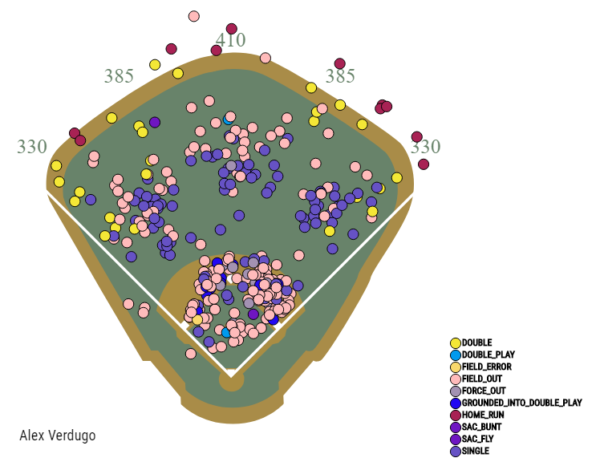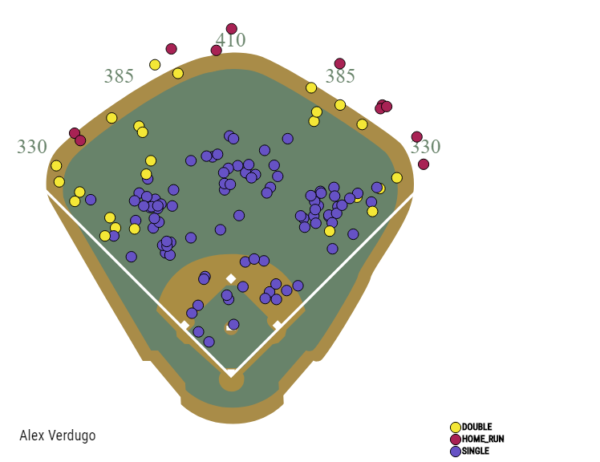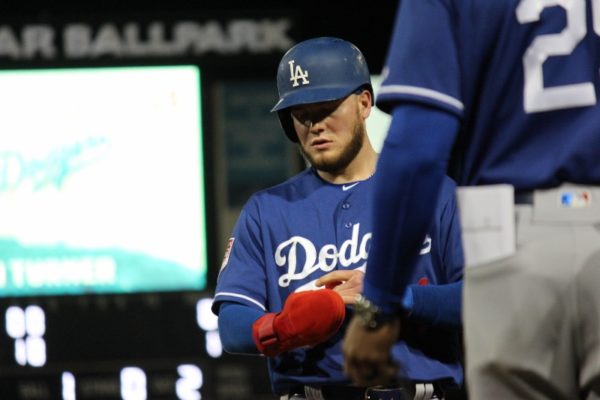We’ve reached the end of the Top 100 prospects saga. We conclude with the prospect who may not have the highest ceiling in the system, but he has the highest floor of any prospect in the system.
Funny thing is, he’s technically not a prospect anymore, but because I started my rankings before the season, he still fell in to that category.
——
Previously
- Introduction
- Past Underrated Prospects
- 100-51
- 50-41
- 40-31
- 30-21
- 20-11
- No. 10 – Estevez
- No. 9 – Downs
- No. 8 – White
- No. 7 – Santana
- No. 6 – Smith
- No. 5 – Gonsolin
- No. 4 – Lux
- No. 3 – May
- No. 2 – Ruiz
——
I’ve included Future Value (FV) grades and risks for the Top 50 prospects. For example, if a guy gets a “50 low,” he has a really good chance to be an average player at his position. If a guy gets a “55 high,” there’s a good chance he won’t reach that ceiling, but the potential is there. I tend to give higher future values because I take ceiling into account. The grades are 20-80 (50 is average), and the risks are as follows:
- Low: Players who are usually older, have debuted, are relievers and/or have higher floors than ceilings
- Medium: Players who are a mix of younger and older, usually have higher floors
- High: Players who are usually younger with potential, but also question marks
- Extreme: Players who are younger with star potential, but a ton of question marks
This is to show what value a player might provide at the MLB level. The higher the risk, the less likely a player will reach that ceiling.
——
Editor’s Note: I am not a scout (#notascout). I am an amateur when it comes to evaluating players. I don’t claim to be a pro, I just want to pass along the information I observe/obtain to the people. Notes and comments are based on personal observation, talking to sources, reading scouting reports and watching video. For future entries in this series: All ratings in the charts below are on the standard 20-80 scouting scale, where 50 is roughly average, 80 is elite and nearly unattainable and 20 is unacceptably poor. Enjoy.
Age is the 2019 season age for the player (June 30 is the cutoff date).
——
Rating Key
| 80 – Elite |
| 70-75 – Plus-plus |
| 60-65 – Plus |
| 55 – Above-average |
| 50 – Average |
| 45 – Fringe-average |
| 40 – Below-average |
| 30-35 – Poor |
| 20-25 – Very Poor |
——
1. Alex Verdugo
| DOB: 5/15/96 | Age: 23 | Height: 6’0 | Weight: 205 | Bats: Left | Throws: Left | Position: OF |
| Tools | Now | Future |
| Hit | 60 | 65 |
| Power | 45 | 50 |
| Speed | 50 | 45 |
| Defense | 50 | 55 |
| Arm | 70 | 70 |
| FV/Risk | 55 | Low |
| Type of hitter: Advanced, line drive, strike zone control | ||
Acquired: 2nd round (No. 62 overall), Sahuaro High School (Ariz.), $914,600 signing bonus
Physical description: Maxed out, solid frame, surprising quickness
Strengths: Advanced bat-to-ball skills, controls strike zone, right fielder’s arm, glimpses of power
Weaknesses: Lacking present power, limited ceiling, off-the-field concerns
Key statistics: .329/.391/.472, 9.0 BB%, 12.4 K%, .143 ISO
Summary: Verdugo might be suffering from prospect fatigue for some, but he’s the best combination of ceiling and floor of any prospect in the system. He has proven himself in the minors and earned a spot on the Dodgers’ Opening Day roster — in a part-time role. One thing that favors him going forward is the fact that he hits left-handed pitching well. In almost 500 career MiLB at-bats, Verdugo has a .318/.376/.434 hitting line against southpaws. He’s ready for a full-time role and would get the chance on almost any other team. That chance will come soon(ish).
As we’ve seen throughout his MiLB career, Verdugo can hit. He uses a level swing path and quick hands to produce above-average bat speed and hit line drives all over the park. His power is mostly to the pull side, but he has shown the ability to hit the ball over the fence to the opposite field. He made some changes last season in an effort to get more elevation on his batted balls. It hasn’t fully translated to more power yet, but that’s partially why scouts think he could be a 15-20 home run guy in the majors. He has an open stance and a great grasp of the strike zone. He can draw a walk and doesn’t strikeout at an alarming rate.
On defense, Verdugo played a lot of center field coming up in the Dodgers’ system. And while he could handle the position in a pinch at the MLB level, he’s not a full-time center fielder. He fits best in right field because of a double-plus arm that had some teams thinking about drafting him as a pitcher back in 2014. His range isn’t great for center, but it’s fine in the corners. He’ll be at least an average defender there with a chance to be above-average because he takes good routes on fly balls. He’s an average runner now, but he’s likely to see his speed diminish a little as he ages (like most players). Still, he’s not a liability on the base paths.
Much has been made about the off-the-field concerns with Verdugo since he as drafted. I blew them off as not a big deal, but they are legitimate. They don’t seem to be hindering him thus far, but it’s something he and the org will have to keep in check and monitor early in his career. As he matures, the hope is those concerns will dissipate.
The risk is low and there’s a chance he could best his above-average future value I’ve put on him. Most of that will depend on how much he can lift the ball. If he can produce average power, you’re looking at an early career Nick Markakis or Christian Yelich. If not, he should still be a quality hitter (around .300 with at least a .350 on-base percentage). That’s a first-division regular. He broke camp with the Dodgers and probably won’t ever see Triple-A again (unless it’s on a rehab assignment). He could hit his way into more playing time, but his first shot at a true full-time role might have to wait until 2020.
Spray Charts


Videos
2018 Ranking: 3
2019 Location: Los Angeles
ETA: Debuted 2017
Next Up: Projected 2022 Lineup & Pitching Staff
 Dodgers Digest Los Angeles Dodgers Baseball Blog
Dodgers Digest Los Angeles Dodgers Baseball Blog
